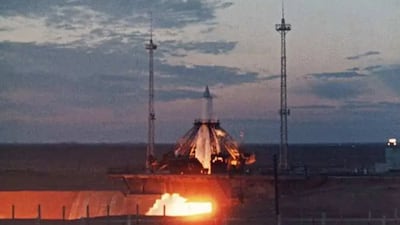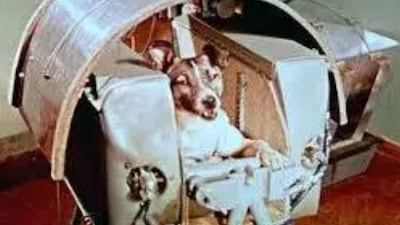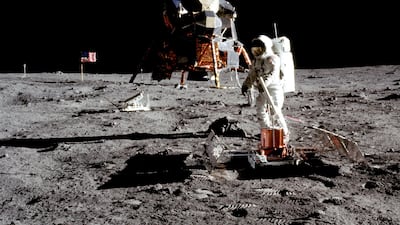A simple “beep-beep” signal broadcast from space 67 years ago on October 4 sent shockwaves across the world.
This mysterious sound, emitted by the world’s first artificial satellite, Sputnik-1, travelled from Earth’s orbit into homes, schools and labs worldwide, capturing the imaginations of people all over the globe.
Launched by the former Soviet Union in 1957, Sputnik-1 was not just the beginning of the space age – it was a pivotal moment that transformed global politics, military strategies and cultural perceptions.
The impact of this historic day is commemorated each year through World Space Week, an annual celebration held from October 4 to 10, marking both the anniversary of Sputnik-1’s launch and humanity's collective achievements in space exploration.
Oleksa Drachewych, a history professor at Western University in Ontario, Canada, told The National that the satellite was a “technological victory” for the Soviet Union during the Cold War, and one that led the US to form Nasa.
“The Americans believed that the Soviets were a notable threat, as Soviet leadership in space exploration was deemed a security concern, while it also questioned American superiority in scientific exploration and technological development,” he said.
“The result was that the United States was spurred to increase its funding on education, scientific and technological development, including with regards to space exploration.
“The Soviets, meanwhile, could use the successes of Sputnik and its following efforts into space exploration to suggest it was more technologically advanced, and in turn, that communism was more advanced than capitalism and liberal democracy.”
Simple but powerful
At its core, Sputnik-1 was a relatively simple device. It weighed 83.6kg and measured just 58cm in diameter, yet it achieved what no human-made object had done before – it became the first to orbit Earth.
Travelling at a speed of 29,000kph, it completed one orbit of the planet about every 90 minutes, at an altitude ranging from 215km to 939km.
As it circled the globe, it transmitted its repetitive “beep-beep” radio signal, which could be picked up by amateur and professional radio operators worldwide.
Sputnik-1's signal continued for 21 days before its batteries ran out, but the satellite remained in orbit for nearly three months before re-entering Earth’s atmosphere and burning up on January 4, 1958.
“Sputnik-1 largely began modern space exploration and satellite navigation,” said Mr Drachewych. “It showed that sending a satellite into low-Earth orbit was possible, and its successors offered further promise for scientific endeavours.”
Just one month after Sputnik-1, the Soviets launched Sputnik-2, which carried a dog named Laika, the first living being sent into space.
Although Laika died a few hours after launch, the mission further showcased Soviet capabilities.
By 1961, the Soviets once again led the Space Race with Yuri Gagarin, the first human to orbit Earth.
Over the following decades, the US and Soviet Union intensified their space programmes, launching satellites and sending humans into space and, in Nasa's case, on to the Moon.
A lasting legacy
Dr Dimitra Atri, a professor and astrophysicist at the New York University Abu Dhabi, told The National that the era had an impact across various industries and not just the space sector.
“This era sparked new aspirations for exploring the Moon, Mars and even interstellar travel, giving rise to a vibrant new genre of science fiction in literature, television, and film,” he said.
“The impact of what I term the ‘Sputnik Revolution’ on the American psyche was so profound that as the Apollo 11 astronauts journeyed to the Moon, they wondered whether they might encounter a Soviet probe along the way.”
By the late 20th century, both superpowers had achieved remarkable feats in space exploration, but the collapse of the Soviet Union in 1991 left Russia with a space programme rich in history but facing numerous challenges, including a lack of financial resources.

In the aftermath of the Soviet collapse, Russia joined forces with Nasa and three other space agencies to build the International Space Station, which has remained a symbol of collaboration in space, despite political disagreements on Earth.
The ISS has served as a crucial platform for scientific research and international co-operation, but with the station set to retire in the near future, Russia is expected to redirect its resources to other space projects – including potential lunar missions and partnerships with China.
In recent years, Russia’s space programme has also faced competition from new players, particularly private companies like SpaceX, which have revolutionised the industry with cost-effective launches.
Russia, however, remains a key player, especially with its Soyuz spacecraft, which continues to reliably transport astronauts to and from the ISS, said Dr Atri. But he said there has been a lack of progress in other areas.
“Although it’s a remarkable achievement, the country has not made significant progress in planetary missions. I think their planetary programme will see a revival through collaboration with China,” he said.
The country’s strategic partnership with China involves developing a joint research base on the Moon. This also reflects the growing political divide between Russia and the West, intensified by Moscow's invasion of Ukraine in 2022.
“Currently, several agencies around the world are planning missions to Venus to study its surface, among other objectives – an achievement the Soviet space programme accomplished in the late 1970s and early 1980s by sharing with us the only photographs of the planet's surface.” said Dr Atri.
The Russia-China alliance also marks a shift in the global space landscape, as both nations aim to challenge US dominance in space exploration.
Meanwhile, China and the US are engaged in a new space race to place the next human on the Moon by the end of this decade.






